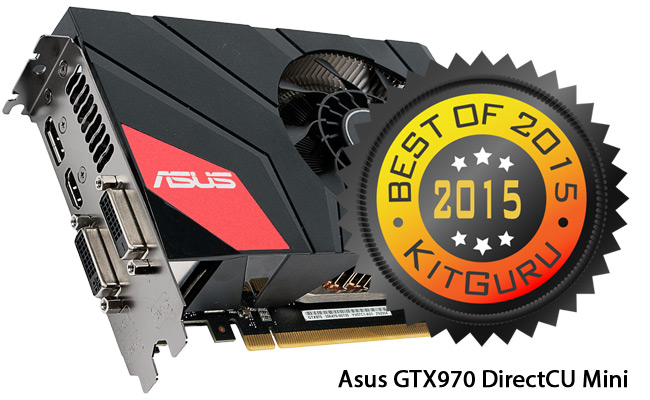Graphics
Without doubt, graphics is the sexiest category in any line up. Processor core speeds and Solid State transfer rates attract enthusiasts and we all love a massive 4K screen, but no part of your PC increases in raw power every couple of years as much as graphics.
With all of the next-gen Pascal cards lined up for somewhere near the second quarter of 2016 and the majority of Maxwell cards already out before the end of 2014, AMD was able to step forward in 2015 with at least one revolutionary technology – High Bandwidth Memory (HBM), the result of a project that AMD kicked off with SK Hynix back in 2008. Unfortunately, in its first incarnation, AMD’s design meant that overall memory was limited to 4GB in the Fury cards.
While HBM is certainly a clever innovation, nVidia’s promise to put 4 times as much ‘HBM2’ on its flagship desktop graphics card in 2016, means that we’ll need to wait a few more months before we can really see the full potential of AMD’s initial vision. AMD themselves will obviously want to dominate, so we will be waiting on what they have planned as well in the coming months.
Finally, we’re introducing an HTPC category this time around. When we interviewed Henry Kao, the global head of Gigabyte’s motherboard business at Computex, one area that he flagged for growth was Mini ITX. The living room gaming battlefield has been the subject of a million memes in 2015, with PC Gaming Royalty claiming all sorts of wins.
For today’s consoles to be truly crushed, we’re gonna want to see some very impressive small graphics cards: Enter the KitGuru HTPC Card of the Year category.
AMD High End
Arctic Islands looks set to land in the Summer of 2016 and will be the first major new series from AMD to benefit from a process node shrinkage since the 7000 series at the start of 2012. Despite that, AMD still managed to launch the most innovative graphics technology of 2015 with HBM – and then coupled that launch with an ingenious repackaging onto one of the smallest PCBs we’ve ever seen for a high-end graphics card.
The Radeon R9 Nano is just 6 inches long and uses a single fan to cool its 175 watt engine. Even so, it comes with 4GB of HBM and delivers up to 1GHz straight out of the box. It’s so small that it barely extended past the edge of the X99 Mini ITX motherboard we used for testing.
This brings us to the all-important numbers. In Fire Strike, this 6” dynamo managed to glide past Asus’ GTX980 Strix – which shows that it can hold its own with the big boys – and at stock speed it managed to average over 34 frames per second in Grand Theft Auto 5 at 4K with image quality set to maximum.
You would imagine that such a small card might suffer from noise in trying to dissipate the heat generated by working so hard, but we were pleasantly surprised. In a small form factor gaming rig, noise levels were on a par with a GTX980. Price-wise, the AMD R9 Nano will set you back around £50 more than an entry level GTX980, but a full length card has no chance of fitting into the smallest of chassis.
At the time of going to press, starting at £409 is what we're seeing. For innovation, performance and sheer cheekiness in design, the Nano is our choice for high end AMD cards.
KitGuru's choice for High End AMD Graphics Card of 2015 goes to the AMD R9 Nano.
AMD Mainstream
No AMD partner works harder at creating innovative cooling solutions than Sapphire. Not every innovation works 100% – as we saw when Sapphire investigated ‘using a stiff shroud in order to replace the rigidity lost by removing the backplate' on some of its early R9 3xx designs.
That said, as soon as we saw the updated R9 390 Nitro (with backplate and 8GB of GDDR5), we knew that Sapphire was onto a winner. This Direct X 12, 28nm card might have 30% less processors than the Fury X, but when you push they clock up from 1,040MHz to 1,133MHz then you can get to an average of 32fps in Grand Theft Auto 5 at 4K with maximum IQ settings – just 5fps behind the stock Fury … but the Sapphire R9 390 Nitro is close to half the price.
At £259 the Sapphire R9 390 Nitro delivers a serious amount of power for the money and the inclusion of the new backplate makes a huge difference in temperatures. When we tested the first version of the card back in June, our Thermal Imaging System showed significant hot spots – with peaks close to 86 degrees. The latest 2015 version shows a drop of almost 30 degrees with no discernible hotspots.
KitGuru has decided that the Sapphire R9 390 Nitro is the Best Mainstream Graphics Card from AMD in 2015.
nVidia High End
The ‘Ti’ variant of nVidia’s top end Maxwell chip delivers such devastating performance that (when clocked/cooled correctly) not even a liquid cooled AMD Fury X with HBM could beat it. So the winner in terms of ‘which chip to pick’ in this category was easy.
That brings us down to the ‘best implementation’. If we tell you that the winner was built-by-robots and incorporates a 14 phase power system, then you’ll know that the results are going to be serious. The Super Alloy II capacitors that are used on the winning card have the potential to last 90,000 hours longer than traditional capacitors.
All of these small details are important, because a chain is only as strong as its weakest link – and the Asus STRIX Gaming GTX 980 Ti DirectCU 3 has no weak points. OK, we did flag the £660 price tag at launch when we tested it, but even that has dropped down to £599.
To win, the Asus card needed to be something very special. Competition in this area is steep. Palit’s Super JetStream was impressive, but we didn’t really expect anyone to superseded the Gigabyte GTX980 Ti G1. Asus managed it with the STRIX Gaming GTX 980 Ti DirectCU 3. In fact, it beat the G1 in every single test – a truly impressive result. In doing so, it ran 4 degrees hotter than the G1 under duress in Furmark, but this was by design.
Asus deliberately set its fan profile for ‘lower noise’ and it worked. In Grand Theft Auto 5 at 4K with maximum IQ, the STRIX breezed past the Titan Z and X cards, while blowing away our overclocked R9 Fury X by almost 24% (average of 9fps faster).
KitGuru’s choice for the Best High End nVidia Card is the Asus STRIX Gaming GTX 980 Ti DirectCU 3.
nVidia Mainstream
After making general interface cards for 6 years, Inno3D became a 3Dfx partner in 1995 and has since been manufacturing millions of graphic cards each year (for a number of brands – as well as its own line up). Back in March, we took delivery of the most ludicrously named card of the year – without any expectations.
We were pleasantly surprised. The GTX 960 has been the chip of choice for nVidia fans wanting decent frame rates at HD resolutions, without breaking the bank. With half the GDDR5 memory and CUDA cores of a GTX980, the Inno3D GTX960 iChill X3 Air Boss Ultra has actually gone up £10 since we reviewed it – but even at the new price of £179, performance is very impressive.
The brash cooler design might be an acquired taste, but there’s no doubting that it does an amazing job of keeping the GPU chilled. When KitGuru Labs applied an extensive period of Furmark to a range of GTX960 cards, the Inno3D managed to stay at 50 degrees – which is 19 degrees cooler than the Palit GTX960 Super JetStream and 10 degrees under the Asus GTX960 Strix OC Edition.
At the same time, the Inno3D was faster than all of the GTX960 cards we tested. More performance and cooler processor? That’s a winning combination in any gamer’s book.
For the Best nVidia Mainstream Graphics Card of 2015, KitGuru's choice is the Inno3D GTX960 iChill X3 Air Boss Ultra.
HTPC Graphics
After all the positive things we said about the R9 Nano, surely it must be KitGuru’s first choice for HTPC graphics, right? Unfortunately, AMD’s ‘French Restaurant’ approach to pricing means that this card requests a significantly higher price without putting much more on your plate. Alongside ‘sensible price’, it’s crucial that our winner in the HTPC category can deliver stunning frame rates at 1080p with low noise. Given that HTPC systems often find themselves in a restricted air-flow environment, running cool would be nice.
Enter the Asus GTX970 DirectCU Mini, a 4GB version of the classic gaming card that’s just over 6” long (17cm). When gaming continuously, it didn’t go above 60 degrees and generated less than 35 dBA – with a complete system load of 226 watts.
All of those numbers are ‘in the zone’ for living room use, but what about the all-important in-game performance? The GTX970 GPU delivered the goods across a range of tests. The slowest average we recorded at 1080p was 64fps in Metro: Last Light Redux set to ‘High Quality’. Grid AutoSport managed a whopping 108fps average at ‘Ultra’ setting. The key thing to remember here is that while consoles try to achieve synchronisation with your TV at 60fps in games, it is only possible by dropping the image quality right down.
There are plenty of ‘Console Vs PC IQ Comparisons’ across the web, well worth checking out. In the meantime, we can confirm that the best choice for a Home Theatre / Gaming PC will set you back around £275.
The best HTPC Graphics Card of 2015 is the 4GB Asus GTX970 DirectCU Mini.
 KitGuru KitGuru.net – Tech News | Hardware News | Hardware Reviews | IOS | Mobile | Gaming | Graphics Cards
KitGuru KitGuru.net – Tech News | Hardware News | Hardware Reviews | IOS | Mobile | Gaming | Graphics Cards







